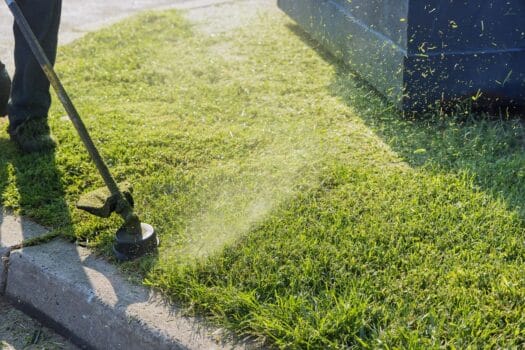Normally, a weed eater consumes one to three liters of gas per hour. However, the gas consumption can differ if you are using a specific type of model or if some external factors cause the device to draw more gas.
The gas consumed by the best 4-cycle weed eater can differ for different reasons and conditions.
For instance, if the weed eater is defective or malfunctioning, it will take a longer time to get the job done. As such, it will consume a lot of gas during that period. Similarly, some models offer various features which require more power.
In this guide, we have covered all topics related to gas consumption and how to reduce your overall expenses.
How Much Gas Does A Weed Eater Use

As we have mentioned earlier, several factors can influence the amount of gasoline a weed eater can consume. After taking a closer inspection, we realized that fuel and oil consumption could vary based on the model you use for mowing weeds.
In this section, we have listed a few weed eaters and how they differ from each other based on gasoline consumption:
1. Household Trimmers
A household trimmer is one of the most common mowers used for mowing grass and weed since it is a lightweight tool. It can be used for cutting tall grass as well as ordinary grass without any difficulty. On average, it produces 1 horsepower or more to get the job done. As such, the device will use around 1 liter of gasoline per hour.
Ideally, this trimmer is recommended for a small volume of work, but if you plan to use it often, the device will require additional oil. Also, this device has a short service life, so you will need to replace them whenever it gets old.
2. Professional Trimmers
Unlike a household trimmer that uses less power, a professional trimmer requires higher power to work efficiently. Thus, it will consume 2-3 liters of gasoline per hour to clean a large lawn within a short period. Nevertheless, a professional trimmer is better than a household trimmer since it has a long service life.
It can cut not only grass but also thin branches and shrubs, which makes it ideal for large projects. Besides this, the knife can be configured for different uses, and it comes equipped with an anti-vibration system and a shoulder strap.
3. Universal Trimmers
A universal trimmer works similarly to a professional trimmer. Hence, it consumes around 2-3 liters of gasoline per hour. However, when it comes to trimming, a universal trimmer offers better performance since it offers a clean and even trim throughout the lawn.
4. Lawn Mowers
Lawn mowers are one of the best weed eaters you can get for your lawn since they can be used to get rid of unwanted branches, shrubs, grasses, and young trees. Plus, these devices can work for several hours without any sort of interruption. As such, each unit consumes around 3 liters of gasoline per hour.
Other Factors That Influence Fuel Consumption
Apart from the type of weed eater you use, other factors can influence fuel consumption. Here are a few of them:
1. Type Of Engine And Power
Normally, a trimmer with a wide range of capabilities will require a stronger engine. Thus, the engine will have a higher amount of fuel and oil consumption. It doesn’t matter if the trimmer uses a reinforced engine or a lightweight engine since it will still consume a lot of fuel.
On the other hand, a two-stroke engine requires less fuel consumption since it has fewer components than a four-stroke engine. However, four-stroke engines produce less noise since they have separate fuel and oil compartments.
2. Surface Of the Plot And Dimension
Most manufacturers produce trimmers that are ideal for flat surfaces, but not all surfaces are flat. Whenever you mow a field, you will experience stones, branches, debris, and stumps interfering in the way and preventing the weed eater from progressing.
As such, more power is needed to get rid of these obstacles so that the lawn is mowed evenly. Thus, your device will have a high fuel consumption if it wants to get the job done.
3. Feature Sets
Nowadays, most modern trimmers come with additional features that allow them to perform functions other than cutting off unwanted grass and weed. For instance, some units come with adjustable handles, allowing users to reach tough places easily.
Similarly, some models allow users to switch between different cutting speeds, which shortens the cutting time. However, the trimmers require more fuel since each feature has a specific fuel requirement.
Moreover, some models come with other features, such as snow removal mode, blade switching mode, and many more, which have different fuel requirements as well.
How To Calculate Oil and Fuel Consumption
One of the easiest ways of calculating oil and fuel consumption is by measuring the waste generated by the burnt fuel within the cycle of its operation. There are two formulas you can use based on the circumstances you are facing.
When it comes to calculating waste from the engine and motor oil during replacements, we use this formula: Qy = ∑q (Qs-Qsl). Here, ∑q stands for the amount of oil being added to the engine.
Qs is the oil that was added to the engine during the replacement, and Qsl is the amount of oil that was drained from the engine.
Apart from this, you can calculate the consumption of a fuel tank that needs to be refilled by using the following formula: MZ = V / (Pk). Here, V stands for the capacity of the entire engine lubrication fuel system, P is the amount of consumed fuel, and k stands for piston wear rate.
Now that we have covered the two important formulas for calculating oil consumption, we would like to share a few instances that can affect the calculation. Firstly, if you use poor-quality lubricants that burn out easily, it will cause your engines to consume more oil and fuel.
Similarly, a malfunction in the engine can also affect oil and fuel consumption. Thus, the formula will be inefficient since it will not be able to determine these external factors. On that note, we highly recommend contacting a professional to measure the fuel consumption of the engine.
In this way, you will get a clear idea about the different factors that can cause the engine to consume more oil and gasoline and how to prevent it. Plus, the chances of making a human error are less when you hire a professional in this field.
How To Reduce Gas Consumption While Using Weed Eaters

Since gasoline and other fuels tend to be costly, here are some ways you can reduce consumption:
1. Use The Right Gas And Fuel
Every lawn mower and petrol trimmer comes with a specific set of instructions given by the manufacturer. Pouring gasoline into the oil tank can cause the device to malfunction instead of working efficiently. As such, careful attention must be given to adding the right fuel to the fuel tank.
Moreover, some models prefer a mixture of fuel and oil to start the engine. On that note, the fuel should be properly mixed with the oil according to the ratio given by the manufacturer.
2. Careful Maintenance
Another important factor you should remember while using a gasoline engine is regular and careful maintenance. If the appliance is not maintained properly, dust and other foreign objects can penetrate the fuel system and cause it to work inefficiently.
In such cases, the engine will need to increase gas consumption to provide the extra power it needs. However, this problem can be avoided if you clean the lawn mower occasionally. Some weed eater brands even offer clear instructions for maintaining the different components. Also, you can always contact a professional if you are having trouble maintaining the weed eater.
3. Replace Consumables And Damaged Parts
Most lawnmowers and weed eaters come with replaceable consumables and parts. For instance, the gas cap, air filter, fuel filter, and gas can be replaced if they are old or defective. If you don’t replace these components on time, it can cause the engine to draw more power by consuming more gas from the tank.
Thus, you should always replace the parts whenever they have completed their short service life. Some brands even provide the extra parts needed to be replaced along with the packaging.
If you are wondering where to purchase the spare parts, you can always contact the weed eater brand or visit the local hardware store. Plus, you can buy parts online but make sure to check the product carefully.
How Much Gas Does A Weed Eater Use Per Hour Frequently Asked Questions ?
How Do You Start A Lawn Mower Engine?
Starting a 2-cycle engine is one of the easiest processes if you follow all the guidelines carefully. Here are the steps you should follow to turn on your lawn mower engine:
- Move the choke lever till it reaches the full position
- Make sure to lock the throttle in the on position
- If your unit has an on/off switch, turn on the switch so the engine can receive the gas from the tank
- Some units might have a primer bulb which you will need to press at least four to five times
- Place the unit on the ground
- Pull the starter rope sharply till you hear the engine running
- Adjust the choke lever to half position and pull the starter rope six more times
- After the engine starts running, you should continue to keep the trigger pressed till it warms up properly
- Once the lawn mower has warmed up, it should have reset the choke lever to the off position, and you are good to go
Which Factors Can Prevent A Lawn Mower Engine From Starting Efficiently?
When it comes to a lawn mower, several reasons can prevent the engine from starting efficiently. So, keep the following points in mind to ensure proper usage of your lawn mower:
- Make sure to use fresh fuel mixture for your engine, as old fuel mixtures can cause a lot of problems
- If your engine has an on/off button, make sure to turn it on
- In some cases, an incorrectly gapped spark plug or a fouled spark plug can prevent the engine from starting
- Sometimes, a dirty air cleaner can prevent the engine from starting since dust and debris block the pipes from within
- Always ensure that the fuel filter is clean.
What Is A Fuel Filter?
A fuel filter is usually found in all gas engines since it helps to filter out unwanted substances and objects from the oil before it reaches the engine. Since fuel filters play a very important role, they should be changed every year for optimum performance. Here are some steps you can follow to replace a fuel filter:
- Always make sure to drain out excess fuel from the unit before replacing the filter
- You can use the gas tank opening to pull or extract the filter from the main line
- Carefully add the new filter on the fuel line and close the tank.
What Is The Difference Between 2-Cycle And 4-Cycle Weed Eaters?
When it comes to the difference between 2-cycle and 4-cycle weed eaters, price isn’t the only factor. In fact, several factors can be used to differentiate between the two units.
For instance, 2-stroke engines are extremely dependable since they are lightweight and cause less vibration. On the other hand, four-stroke engines tend to be bulky, but they can cover a larger plot within a short span of time. As such, they help to reduce the fatigue of the operator.
Another key difference between 2-cycle and 4-cycle weed eater is the amount of oil and gas it consumes. 2-stroke engines usually require the operator to mix oil and gas in exact ratios. In This way, the oil becomes the lubricant for the crankcase.
The 4-stroke engine uses oil and gas separately, which saves the operator a lot of time since they don’t need to worry about making the perfect fuel mixture. Plus, 2-cycle engines have lesser moving parts in the engine. This makes it easier to maintain the engine than a 4-cycle string trimmer.
What Kind Of Gas Does A 4-Cycle Weed Eater Use?
Unlike regular gas engines, the kind of gas a 4-cycle weed eater uses is totally different since it requires more gasoline to run efficiently. On that note, it is recommended to use 87-octane regular unleaded gasoline for a 4-cycle lawn trimmer.
However, this type of gasoline might not be available in every gas station. As such, you can blend your own mixture for the 4-cycle gasoline trimmers by mixing gasoline with 10% of alcohol. While mixing the two liquids, always make sure to use fresh gas since it helps to prolong the life of the 4-cycle gasoline trimmer and offers better engine power.
Since 4-cycle gasoline engines usually have separate tanks for gasoline and engine oil, you can fill the gasoline in the gasoline tank and the engine oil in the oil tank.

How Much Gas Does A Weed Eater Use Per Hour Conclusion
With that, we have reached the end of this extensive guide. We genuinely hope this guide provided you with the necessary information you were looking for. Before signing off, we would like to share a few tips that can help you save gas while using a weed eater.
For starters, always make sure to clean and maintain the weed eater occasionally. This will ensure that dust and debris don’t clog any internal components and prevent them from operating efficiently.
Secondly, we suggest replacing any damaged or old components since they will require more gas to work efficiently. By replacing the defective components, you can save a lot of money on gas, and the gas mowers will work more efficiently.
Lastly, make sure to pick the right fuel for your lawn mower since using the incorrect fuel can cause damage to the gas tank and other components.
That said, it’s a wrap. See you next time!


